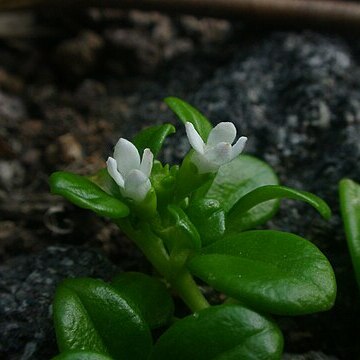Herbs, subshrubs, or shrubs, annual or perennial, procumbent to erect or climbing, unarmed. Raphides present. Leaves opposite [or rarely whorled], sometimes clustered at ends of stems, without domatia; secondary venation rarely triplinerved or palmate; stipules persistent, interpetiolar, fused to petiole bases, or united around stem, triangular to truncate, entire or ciliate to laciniate, erose, 1-to several lobed and/or-setose. Inflorescences terminal, pseudoaxillary, and/or axillary, few to many flowered and fasciculate, cymose, paniculate, capitate, or glomerulate or reduced to 1 flower, sessile or pedunculate, bracteate or bracts reduced. Flowers pedicellate or sessile, bisexual and monomorphic or distylous [to unisexual on dioecious plants]. Calyx limb shallowly to deeply (2-)4-lobed (or 5-lobed, Hedyotis hainanensis). Corolla white, pink, purple, or blue, tubular, funnelform, salverform, rotate, or urceolate, variously glabrous or pubescent inside; lobes (2-)4(or 5, H. hainanensis), valvate in bud. Stamens 4(or 5, H. hainanensis), inserted in corolla tube or throat, included or exserted; filaments developed to reduced; anthers dorsifixed often near base. Ovary 2-celled, ovules few to numerous or rarely 1 in each cell on axile placentas; stigma 2-lobed with lobes linear to clavate or rarely undivided, included or exserted. Fruit indehiscent, schizocarpous, or capsular, generally subglobose to ovoid or dicoccous, crustaceous to membranous or leathery, when schizocarpous splitting into 2 mericarps, when capsular splitting partially to entirely septicidally and/or loculicidally, subsequently sometimes splitting other way, apically flattened or with short to well-developed beak (i.e., disk area inside calyx limb), sometimes dehiscent primarily through beak, with calyx limb persistent; seeds few to numerous, small, angular or plano-convex; testa smooth, reticulate, or otherwise variously ornamented; endosperm fleshy; radicle clavate or terete.
More
Fls 4-merous; sep lance-linear to ovate; cor salverform or funnelform to subrotate; stigmas 2; capsule partly to wholly inferior, with several to many seeds in each of the 2 locules, loculicidally dehiscent across the top; mostly herbs with small, opposite lvs and rather small to minute fls. (Houstonia, Oldenlandia) 300, cosmop., especially in warm regions. Spp. 1–4 apparently hybridize.

